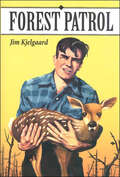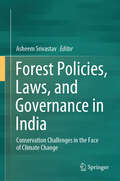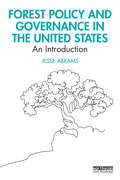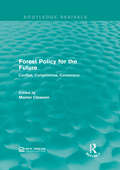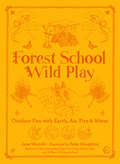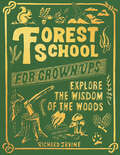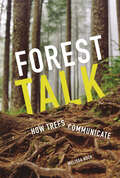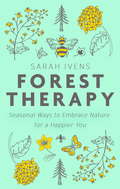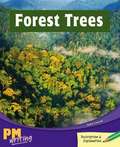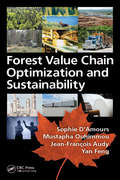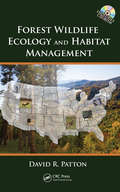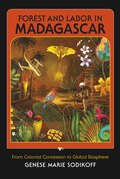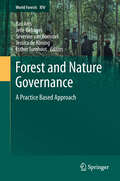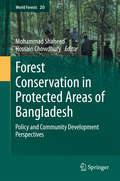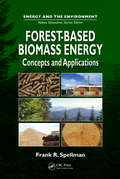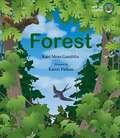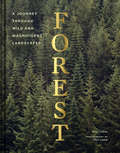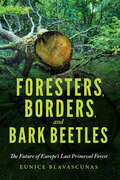- Table View
- List View
Forest Patrol
by Jim KjelgaardSome day, John Belden told himself, he would be a forest ranger. His chance came unexpectedly as a one-year substitute in the Rasca district of the Alleghany back country. This is the story of that year-plowing roads, fighting fires, hunting killer bears and wolves, planting trees, attending to all the duties that make up a rangers life. But more than anything else it is the story of a nineteen-year-old boys finding himself and learning that success is not just heroics, but constantly doing your best.
Forest Policies, Laws, and Governance in India: Conservation Challenges in the Face of Climate Change
by Asheem SrivastavThe book delves into the intricate relationship between India’s forest governance, laws, and policies over time, examining their effects on the quality and coverage of the country’s forests. Historically, especially during the British era and the initial phase following independence, forests were valued for timber, leading to increased deforestation to fulfill the rising demands of shipbuilding, railways, residential construction, and industry. The economic benefits derived from converting forest land for developmental purposes were a key factor in this trend. However, recent statistics indicate that except Maharashtra, most of the forest rich states including MP and Chhattisgarh have lagged in economic development. The history of overexploitation and diversion for non-forestry use has also led to less forest area per capita. India has lost tree biomass much more than its productivity potential, and the average biological productivity of Indian forest is much below the global average. It is extremely important to restore the health of natural forests which are, by far, the best and a highly cost-effective carbon sequestering machine provided by nature. The book also provides research data, both at national and global scales to convincingly put forward the contention that natural forests are sine qua non and under no circumstances can farm and roadside plantations, tea and coffee plantations, and orchards be a substitute for natural forest for three important reasons: (1) the influence of natural forest on rainfall, (2) the complexity in maintaining energy flow, and (3) the impact of natural forest or deforested sites on soil.
Forest Policy and Governance in the United States: An Introduction
by Jesse AbramsThis new textbook provides an up-to-date and comprehensive introduction to both the policy background and contemporary governance of forests in the United States. Starting with a history of the development of forest policies and conservation agencies, the book then explores the diversity of forest owners, users, and uses and examines emerging approaches to forest governance that cross traditional jurisdictional and property boundaries. It tackles key contemporary issues such as the forest water nexus, the conservation of threatened and endangered species, and the challenges of managing fire, insect, and disease dynamics under a changing climate. Key focal areas include the emergence of collaborative approaches to forest governance, community forest relationships, changes to corporate timberland ownership, and contemporary governance mechanisms such as certification and payments for ecosystem services. This text raises the "big questions" about the distribution of rights and responsibilities in forest management, the tensions between equity and efficiency, and how to sustain a diversity of forest values under the pressures of ecological and social complexity. Written in an accessible and engaging manner, this textbook provides a timely synthesis of both the foundations and current trends and issues in forest policy and governance in the United States with a strong emphasis on illustrative real-world cases. Forest Policy and Governance in the United States is essential reading for students in forest and natural resource policy courses and will be of great use to students in environmental governance courses. It will also be of interest to policymakers and professionals working in forest conservation and in the forest industry.
Forest Policy for the Future: Conflict, Compromise, Consensus (Routledge Revivals)
by Marion ClawsonThe use and management of forests in the United States, especially the public owned ones, have been the focus of considerable controversy. First published in 1974, this volume, a collection of papers originally delivered at the RFF Forest Policy Forum, explores alternative forest management programmes to see what is biologically, economically, socially and politically possible. This title is a valuable resource for students interested in environmental studies, as well as for policy makers.
Forest Politics from Below: Social Movements, Indigenous Communities, Forest Occupations and Eco-Solidarism (Contributions to Political Science)
by Ricardo KauferThis book presents an analysis of forest politics that employs a broader scope to include non-institutionalized actors. It offers a comparative perspective on various environmental social movements fighting to protect forests around the globe, including indigenous communities in the Amazon and eco-anarchists in Europe. By examining the political goals, motives, and tactics of these sometimes-radical environmentalists, it helps readers understand the commonalities and differences among these “grass-roots forest politicians.” In addition, the book highlights the importance of forest-related struggles for a just transition to a carbon-neutral future. Accordingly, it will appeal to scholars of political science, public policy, and political sociology, as well as anyone interested in social movements and forest conservation.
Forest Prairie Edge: Place History in Saskatchewan
by Merle MassieSaskatchewan is the anchor and epitome of the ‘prairie’ provinces, even though half of the province is covered by boreal forest. The Canadian penchant for dividing this vast country into easily-understood ‘regions’ has reduced the Saskatchewan identity to its southern prairie denominator and has distorted cultural and historical interpretations to favor the prairie south. Forest Prairie Edge is a deep-time investigation of the edge land, or ecotone, between the open prairies and boreal forest region of Saskatchewan. Ecotones are transitions from one landscape to another, where social, economic, and cultural practices of different landscapes are blended. Using place history and edge theory, Massie considers the role and importance of the edge ecotone in building a diverse social and economic past that contradicts traditional “prairie” narratives around settlement, economic development, and culture. She offers a refreshing new perspective that overturns long-held assumptions of the prairies and the Canadian west.
Forest Regeneration in Ontario: Based on a Review of Surveys Conducted in the Province during the Period 1918-1951 (University of Toronto Forestry Bulletin #no. 2)
by R. C. HosieThis volume reports all the information presently available from the fifty-seven regeneration surveys carried out to the present by government and private agencies within the Province of Ontario. <P><P>It presents a general view of the nature of tree reproduction on cut-over forest land, followed by an analysis of the procedure in conducting and reporting regeneration surveys, and conclusions and recommendations for the conducting of future surveys.
Forest School Wild Play
by Jane WorrelAimed at parents, teachers and Forest School leaders, this new book from Jane Worroll & Peter Houghton is packed full of fantastic new Forest School activities. It has a special focus on the elements and on making children feel connected to the natural world through imagination and storytelling. The ultimate antidote to screen time – outdoor play with your kids! Whether you are a parent, a teacher, a Forest School leader or anyone else looking after children, this invaluable guide to nature-based play is full of ideas to get kids outdoors, learning about and connecting with nature, developing new skills and having fun. These new Forest School crafts, games and survival activities are all themed around the elements of earth, air, fire and water, with an underlying message of sustainability and wonder at the amazing web of life. For earth, make a mud slide, try Bogolan mud painting on cloth, or hurl mud missiles at a moving target. For air, make a bullroarer or a whistle, build a kite and fly it, or predict the weather by reading the clouds. For fire, dig a Dakota fire pit, make a bug-repellent torch or learn how to navigate using a shadow stick. For water, mix natural dyes, build and test a rainproof den, or drink foraged birch twig tea from a crafted log cup. There are also four magical stories to tell the children – one for each of the elements –guaranteed to spark their imagination.
Forest School for Grown-Ups: Explore the Wisdom of the Woods
by Richard IrvineFrom starting a fire to foraging for food, basket making to making a bird feeder, tree hugging and cloud scrying, this beautifully designed forest almanac is a treasure for anyone who loves the outdoors.Forest schools for kids originated in Scandinavia as outdoor play-based learning groups, and in 2016 The Forest School Foundation was established in the USA. But why should kids have all the fun? Connecting with green spaces, trees, and plants can lift our spirits, lower our stress levels, and relax our brains – in short, playing outside is good for adults, too.Forest School for Grown-Ups is here to help. A gorgeous and comprehensive guide to all things outdoors for anyone who loves being in and interacting with nature, readers will learn how to make a rope sing, go forest bathing, read flowers, build a campfire, and make a forest potion. From practical tips and how-tos to forest folklore, there's something for everyone.Exquisite lino cut art and illustrations run throughout, along with step-by-step instructions, diagrams, and more. Forest School for Grown-Ups provides the perfect resource for people of all ages to enjoy spending quality time outdoors. From starting a fire to foraging for food, basket making to making a bird feeder, tree hugging and cloud scrying, this beautifully designed forest almanac is a treasure for anyone who loves the outdoors.HANDY AND INFORMATIVE: Comprehensive collection of all things trees, loaded with practical content with a rich, powerful design, making it the perfect gift for anyone who loves the outdoorsBEAUTIFUL AND DISTINCTIVE: Features unique handmade linocut art.FAMILY-FRIENDLY: Family-friendly, for all agesPerfect for:• Anyone who loves the outdoors, camping, trees, and nature• Father's Day, birthday, and holiday gift-givers
Forest Talk: How Trees Communicate
by Melissa KochTrees are essential. They provide water, shelter, and food for millions of plant and animal species, including humans. They deliver proven health benefits, and they capture and store carbon, which combats climate change. Yet trees are in trouble. Forests are struggling to adapt to climate change, and deforestation is a major threat. Recently, researchers and citizen scientists made the surprising revelation that trees communicate with each other through an underground system of soil fungi and other methods. Complex social networks help trees survive and thrive by transferring resources to each other, sending defense signals, communicating with their kin, and more. Meet the tree scientists and learn more of their fascinating discoveries.
Forest Therapy: Seasonal Ways to Embrace Nature for a Happier You
by Sarah IvensYour practical guide to better health, stronger relationships, and a happier life--by reconnecting with nature There is something simply soul-soothing about being in nature. In fact, research shows that spending time outside can improve the immune system, combat stress hormones, lower blood pressure, and boost self-esteem. Around the globe, rising movements are driving us to reconnect with Mother Nature--from shinrin-yoku ("forest bathing") in Japan to friluftsliv ("open-air life") in Scandinavia--yet our everyday lifestyles have distanced us from the great outdoors. For stressed-out professionals, reclusive bookworms, worn-out parents, and their cooped-up kids, Forest Therapy shares why getting back to nature is critically important for our well-being, and offers fun, easy practices to break out of hibernation.Forest bathing is a rising trend, but what to do if you're not near the woods or if the weather is dreary? Forest Therapy offers practical steps and inspiration to tap into nature's restorative power, no matter the season or the weather. Chapters address ideas for all four seasons, as well as ways to use experiences in nature as ways to deepen your relationships with your children, partner, and friends. Ivens's creative ideas and strategies range from a simple walk in the woods and countryside couples' therapy to DIY natural beauty products and simple ways to bring the great outdoors into your home. Illustrated with charming black-and-white line art, Forest Therapy is a warm, witty, and personal guide to improving your health, finding happiness, and living a fabulous al fresco life.
Forest Therapy: Seasonal Ways to Embrace Nature for a Happier You
by Sarah IvensWho hasn't felt better after a walk in the woods, a picnic alfresco or a swim in the sea? There is something soul-soothingly simple and refreshing about getting back to nature, about making the most of the great outdoors, being mindful of Mother Nature's gifts and grabbing spring and summer - and those blue sky, brisk days of autumn and winter - with both hands. But sadly it is a skill we are losing. We are becoming creatures wrapped in walls and trapped by to-do lists, hibernating while the world sprouts, grows and changes.From a simple walk in the woods and countryside couples therapy to DIY natural beauty products and how to bring the outdoors to your home, Forest Therapy will provide seasonal tips to help you reconnect with nature. This book is not just for mountain climbers or white water rafters - it is for uninspired fathers wanting to reconnect their families, bookworms looking to shake off their cobwebs, cooped-up kids needing to let off steam, stressed-out professionals wanting to stop and smell the flowers and worn-down mums needing a rejuvenating boost. We all know getting outside is good for us. Our ancestors did it. We should too. This book will help you live your most unforgettable, fabulous alfresco life.
Forest Therapy: Seasonal Ways to Embrace Nature for a Happier You
by Sarah IvensWho hasn't felt better after a walk in the woods, a picnic alfresco or a swim in the sea? There is something soul-soothingly simple and refreshing about getting back to nature, about making the most of the great outdoors, being mindful of Mother Nature's gifts and grabbing spring and summer - and those blue sky, brisk days of autumn and winter - with both hands. But sadly it is a skill we are losing. We are becoming creatures wrapped in walls and trapped by to-do lists, hibernating while the world sprouts, grows and changes.From a simple walk in the woods and countryside couples therapy to DIY natural beauty products and how to bring the outdoors to your home, Forest Therapy will provide seasonal tips to help you reconnect with nature. This book is not just for mountain climbers or white water rafters - it is for uninspired fathers wanting to reconnect their families, bookworms looking to shake off their cobwebs, cooped-up kids needing to let off steam, stressed-out professionals wanting to stop and smell the flowers and worn-down mums needing a rejuvenating boost. We all know getting outside is good for us. Our ancestors did it. We should too. This book will help you live your most unforgettable, fabulous alfresco life.
Forest Tree Breeding in Europe: Current State-of-the-Art and Perspectives
by Luc E PâquesForest tree breeding has been ongoing for more than 70 years across Europe. It has successfully generated improved varieties for the major economical forest tree species. They are part of the present European forestry landscape and largely contribute to intensive wood production and other forest activities. In this book, we describe the state-of-art of breeding for the main forest tree species. We provide a comprehensive, unique and up-to-date overview of the major scientific results and breeding achievements gathered from the many programmes scattered across Europe. The book is divided into 10 chapters, each as a monograph corresponding to a species or group of species Abies spp., (Larix spp., Picea abies, Picea sitchensis, Pinus sylvestris, Pseudotsuga menziesii, and Mediterranean pines; Acer pseudoplatanus, Fraxinus excelsior, and Prunus avium). Each of them is written by a group of experts and focuses on the distribution and economical importance of the species; motivation for breeding and breeding objectives; intraspecific genetic variability, breeding populations and breeding strategy; forest reproductive material deployment including mass-propagation and, prospects and perspectives for joint research and breeding. The book is a unique and up-dated source of information for students, researchers and professionals interested in the genetics and domestication of forest tree species.
Forest Trees (Into Reading, Level O #56)
by Sally Cowan Andrew LoueyNIMAC-sourced textbook <p><p> A giant has been discovered deep in the forests of Tasmania. How did it come to be? Are there others like it? And why is this giant—measuring in at just under 100 meters tall—called Centurion?
Forest Value Chain Optimization and Sustainability
by Sophie D’Amours, Mustapha Ouhimmou, Jean-François Audy and Yan FengThis book provides a global perspective on the various issues that the industry has to face as well as to provide some key global strategies that can help coping with those global challenges, such as collaboration, strategic value chain planning, and interdependency analyses. It presents literature reviews, strategic research orientations, assessment of some current key issues, and state-of-the-art methodologies.
Forest Wildlife Ecology and Habitat Management
by David R. PattonAcross the continental United States, one can identify 20 distinct forest cover types. Most of these are to be found on federal lands managed by the U.S. Forest Service and Bureau of Land Management. Those responsible for the management of trees that form the 20 different cover types and the diversity of forest wildlife that reside in them must hav
Forest World
by Margarita EngleFrom award-winning author Margarita Engle comes a lively middle grade novel in verse that tells the story of a Cuban-American boy who visits his family’s village in Cuba for the first time—and meets a sister he didn’t know he had.Edver isn’t happy about being shipped off to Cuba to visit the father he barely knows. The island is a place that no one in Miami ever mentions without a sigh, but travel laws have suddenly changed, and now it’s a lot easier for divided families to be reunited. Technology in Cuba hasn’t caught up with the times, though, and Edver is expecting a long, boring summer. He was NOT expecting to meet a sister he didn’t know he had. Luza is a year older and excited to see her little brother, until she realizes what a spoiled American he is. Looking for something—anything—they might have in common, the siblings sneak onto the Internet, despite it being forbidden in Cuba, and make up a fake butterfly. Maybe now their cryptozoologist mother will come to visit. But their message is intercepted by a dangerous poacher, and suddenly much more than their family is at stake. Edver and Luza have to find a way to overcome their differences to save the Cuban jungle that they both have grown to love.
Forest and Labor in Madagascar: From Colonial Concession to Global Biosphere
by Genese Marie SodikoffA study of the demands of economic development and ecological conservation on the African island country.Protecting the unique plants and animals that live on Madagascar while fueling economic growth has been a priority for the Malagasy state, international donors, and conservation NGOs since the late 1980s. Forest and Labor in Madagascar shows how poor rural workers who must make a living from the forest balance their needs with the desire of the state to earn foreign revenue from ecotourism and forest-based enterprises. Genese Marie Sodikoff examines how the appreciation and protection of Madagascar’s biodiversity depend on manual labor. She exposes the moral dilemmas workers face as both conservation representatives and peasant farmers by pointing to the hidden costs of ecological conservation.“Sodikoff takes us deep into the underbelly of conservation in one of the world’s biodiversity “hot-spots.” It is a world of timber barons, logging gangs, corrupt state functionaries, international conservation experts, worker-peasants, and poachers. She paints eastern Madagascar as a frontier of dispossession, exploitation, and violence. The plundering of the Mananara protected area is seen, in a brilliantly original way, from the subaltern vantage point of forest workers and conservation labor. Forest and Labor places present day conservation on the larger canvas of a century of forest-based social relations of labor that have entered into the making of what Sodikoff calls neoliberal conservation. It is a magnificently rich historical and ethnographic accounting of what passes as the making of global biosphere reserves. A tour de force.” —Michael Watts, UC Berkeley“An important and lively contribution to the study of “green neoliberalism.” An obvious choice for undergraduate teaching on ecology, rights, international political economy, development, and a host of other topics.” —David Graeber, University of London“Brings a whole new angle and nuance to the crucial debates over conservation and development. Applicable not just to lush, humid eastern Madagascar, but all around the globe.” —Christian Kull, Monash University“Those interested in conservation, tropical rainforest ecology, international political economy, and sustainable development will find Forest and Labor in Madagascar an insightful case study.” —Choice
Forest and Nature Governance
by Jelle Behagel Bas Arts Jessica De Koning Esther Turnhout Séverine Van BommelToday, problems such as deforestation, biodiversity loss and illegal logging have provoked various policy responses that are often referred to as forest and nature governance. In its broadest interpretation, governance is about the many ways in which public and private actors from the state, market and/or civil society govern public issues at multiple scales. This book takes a fresh perspective on the study of forest and nature governance. Departing from 'practice theory', and building upon scholars like Giddens, Bourdieu, Reckwitz, Schatzki and Callon, it seeks to move beyond established understandings of institutions, actors, and knowledge. In so doing, it not only presents an innovative conceptual and methodological framework for a practice based approach, but also rich case studies and ethnographies. Finally, this book is about how actors involved in governance talk about and work with trees, forests, biodiversity, wildlife, and so on, while acting upon forest policies, environmental discourses, codes of conduct, or scientific insights.
Forest conservation in protected areas of Bangladesh
by Mohammad Shaheed Hossain ChowdhuryThis book dealt with a number of issues under the broad subject matter of protected area focusing on the policy of collaborative management as a means to augment the forest conservation activities and enhance community development in Bangladesh. Studies covered in the book emerged with the success stories of protected area co-management, both in terms of community development and biodiversity conservation. Significant level of development was noticed in the socio-economic conditions of the surrounding communities. Empowerment and improved social dignity of women participants signifies the initiation of co-management approach. The principles of participatory governance were found reasonably well reflected in legal and policy frameworks. Based on the lessons from the studies, a general metaphysical model, namely 'Spider-web model of protected area co-management' has been developed that can be potentially applicable in countries where local communities rely heavily on protected areas.
Forest-Based Biomass Energy: Concepts and Applications (Energy and the Environment)
by Frank SpellmanWhat is forest-based biomass energy and why should we care? Written by environmental expert Frank Spellman, Forest-Based Biomass Energy: Concepts and Applications details how forest biomass can be converted to energy and energy products, including direct combustion, pellets, gasification, and co-firing. It explores the possibilities of forest-based
Forest: A See to Learn Book (See to Learn #1)
by Kate Moss GamblinForest: A See to Learn Book is the first book in a series of non-fiction picture books for very young children, using lyrical phrasing to encourage a sensitive perception of the natural world and a caring connection with it.Through gentle questions, the text asks young readers to consider what they see and experience in the forest through the seasons — animal tracks, tiny creatures in the soil, birds soaring in the sky above, towering trees, shade and dappled sunlight — drawing local connections alongside those of a global sensibility.Stunningly beautiful illustrations show a child and grownup exploring the forest, appreciating its beauty, learning its secrets and enjoying moments of wonder, all first steps toward developing a lifelong awareness of our interconnectedness to the Earth and our impact on the environment.Key Text Featuresauthor’s noteCorrelates to the Common Core State Standards in English Language Arts:CCSS.ELA-LITERACY.RL.K.1With prompting and support, ask and answer questions about key details in a text.CCSS.ELA-LITERACY.RL.1.4Identify words and phrases in stories or poems that suggest feelings or appeal to the senses.CCSS.ELA-LITERACY.RL.1.5Explain major differences between books that tell stories and books that give information, drawing on a wide reading of a range of text types.
Forest: Walking Among Trees
by Matt CollinsBrimming with engaging writing and stirring photography, Forest is an ode to the natural world and a celebration of the relationship between humans and trees.Discover the secrets hidden within the Earth's lush woodlands and wild landscapes through photographs and stories about enchanting forests, magnificent trees, and people who live off the land.Journeying across North America, the United Kingdom, and Europe, writer Matt Collins and photographer Roo Lewis capture the history, science, and human stories behind some of the most enchanting natural environments in the world. • Explores the captivating history behind some of the world's most enchanting forests• Organized by tree species, including the hearty pines in Spain's Tamada forest, the towering firs of the American West, the striking Birch groves of Germany's Elbe Valley, and beyond• A blend of beautiful photographs, scientific trivia, and engaging human storiesForest is an arresting tribute to the magnificence of the natural world and a wonderful gift for anyone who enjoys spending time in the outdoors.Complete with gorgeous photography and engaging stories of people living in harmony with nature, readers will learn everything they dream of knowing about the forests of the world. • A handsome gift for photographers, travel and outdoor enthusiasts, environmentalists, and science lovers• A stunning way to learn about the world and the trees that surround us• Great for readers who couldn't get enough of The Hidden Life of Trees by Peter Wohlleben, Ancient Trees by Beth Moon, and Wise Trees by Diane Cook and Len Jenshel
Foresters, Borders, and Bark Beetles: The Future of Europe's Last Primeval Forest
by Eunice Blavascunas“A compelling investigation of the pasts and possible futures of a critical ecosystem in an era of globalization and rising nationalism.” —Andrew S. Mathews, author of Instituting NatureIn Europe’s last primeval forest, at Poland’s easternmost border with Belarus, the deep past of ancient oaks, woodland bison, and thousands of species of insects and fungi collides with authoritarian and communist histories.Foresters, biologists, environmentalists, and locals project the ancient Bialowieza Forest as a series of competing icons in struggles over memory, land, and economy, which are also struggles about whether to log or preserve the woodland; whether and how to celebrate the mixed ethnic Polish/Belarusian peasant past; and whether to align this eastern outpost with ultraright Polish political parties, neighboring Belarus, or the European Union. Eunice Blavascunas provides an intimate ethnographic account, gathered in more than 20 years of research, to untangle complex forest conflicts between protection and use. She looks at which pasts are celebrated, which fester, and which are altered in the tumultuous decades following the collapse of communism.Foresters, Borders, and Bark Beetles is a timely and fascinating work of cultural analysis and storytelling that textures its ethnographic reading of people with the agency of the forest itself and its bark beetle outbreaks, which threaten to alter the very composition of the forest in the age of the Anthropocene. “Through vivid storytelling, Eunice Blavascunas illuminates the durability of struggles around national identity and history—and the ways those struggle shape debates over ecology and nature conservation—in one of Europe’s quintessential borderlands.” —Katrina Z. S. Schwartz, author of Nature and National Identity after Communism
